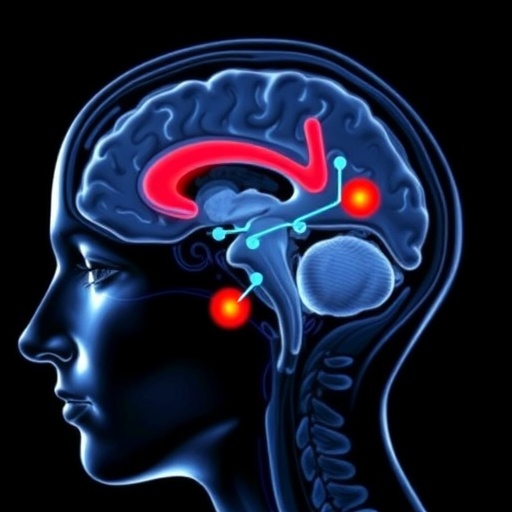In recent years, the scientific community has witnessed a growing interest in oxytocin, a hormone traditionally associated with social bonding and reproductive behaviors. New research led by Moshfeghinia et al. has taken a significant step towards understanding the potential of intranasal oxytocin (OXT) in treating anxiety and stress-related disorders. By utilizing functional magnetic resonance imaging (fMRI), the study offers a comprehensive exploration of how OXT might influence brain activity in individuals struggling with these prevalent mental health issues.
Oxytocin, often dubbed the “love hormone,” is secreted by the hypothalamus and plays a crucial role in social interactions. Beyond its reproductive implications, emerging evidence suggests that oxytocin could be pivotal in modulating emotional responses and stress reactivity. Given the increasing prevalence of anxiety disorders worldwide, researchers are particularly keen on investigating innovative therapeutic avenues, and OXT stands out as a promising candidate.
The systematic review conducted by Moshfeghinia and colleagues meticulously analyzed existing studies that have incorporated fMRI technology to assess the effects of intranasal OXT. This approach is particularly valuable because it allows for the observation of real-time neural shifts in response to oxytocin administration, providing more insight into the underlying mechanisms at play. Such advancements in neuroimaging techniques not only enhance our understanding of the neurobiological basis of anxiety but also illuminate potential interventions.
The review highlights various studies where participants who received OXT exhibited changes in brain regions associated with emotional regulation, such as the amygdala and prefrontal cortex. Increased connectivity between these areas can facilitate improved emotional processing, potentially leading to reduced feelings of anxiety. These neurophysiological changes are critical in understanding how oxytocin could alleviate symptoms in individuals plagued by anxiety disorders.
Moreover, the findings from this systematic review point to the variability in individual responses to OXT. Factors such as genetic predispositions, baseline anxiety levels, and the specific nature of anxiety disorders can influence how effectively intranasal oxytocin may work. This underscores the need for personalized approaches in utilizing OXT as a therapeutic tool, as a one-size-fits-all strategy may not be universally effective.
The role of the amygdala in anxiety is particularly noteworthy. Studies have consistently shown that heightened amygdala activity is associated with increased anxiety and fear responses. The review details how intranasal oxytocin administration resulted in decreased amygdala activation, indicating a potential pathway through which OXT may exert its anxiolytic effects. This finding could open doors to developing targeted treatments that specifically aim to modulate amygdaloid activity through oxytocin.
In addition to amygdala activity, the research also sheds light on the influence of OXT on the prefrontal cortex—a region integral for cognitive control and decision-making. Enhanced functioning of the prefrontal cortex, exacerbated by oxytocin, may offer additional layers of emotional regulation for individuals suffering from anxiety. This interplay between the amygdala and prefrontal cortex highlights the complex neural networks involved in emotional processing and the potential modifications that OXT can induce.
Critically, the review does not shy away from discussing the limitations of the studies examined. Many of the trials included are small-scale or lack comprehensive long-term follow-up assessments. Additionally, discrepancies in dosing, administration techniques, and measures used to evaluate anxiety contribute to the variability in study outcomes. Thus, while the evidence is promising, it is imperative that future studies adopt standardized methodologies to ascertain the reliability of the findings.
The implications of the research are not only relevant for clinical psychology but also for broader public health discussions. With anxiety disorders being one of the most prevalent mental health issues globally, alternative treatments such as OXT warrant serious consideration, especially in contexts where traditional therapies may fall short. The review acts as a call to action for further exploration and investment in the field of oxytocin research as a means to address growing mental health crises.
Moreover, the potential for oxytocin to bridge gaps in current treatment paradigms cannot be overstated. Many patients experience significant side effects from conventional anxiety medications, leading to non-compliance and worsening symptoms. In contrast, the administration of OXT via intranasal methods could provide a more tolerable alternative with fewer adverse effects, fostering better patient outcomes and adherence to treatment regimens.
The research team behind the systematic review also advocates for larger, more diverse clinical trials moving forward. It is essential to include varied demographics to better understand how different socio-cultural factors might affect the efficacy of intranasal OXT. Furthermore, inquiries into the long-term impacts of oxytocin treatment should be prioritized to ensure its safety and effectiveness in a broader clinical context.
In conclusion, the systematic review conducted by Moshfeghinia et al. illuminates the potential role of intranasal oxytocin in treating anxiety and stress-related disorders. As interest in neurochemical interventions grows, OXT emerges as a particularly fascinating topic, warranting further investigation and clinical exploration. With ongoing advancements in neuroimaging, the field is better equipped than ever to unlock the intricacies of human emotion and pave the way for innovative therapeutic strategies against anxiety.
As we continue to navigate the complexities of mental health, research such as this fosters a growing hope that effective, science-backed interventions are on the horizon. The journey toward fully understanding the mechanisms and benefits of oxytocin is just beginning, but the potential for change is palpable. Encouraging interdisciplinary collaborations and highlighting the need for robust clinical trials will be essential as we aim to leverage oxytocin’s benefits against anxiety that afflict millions worldwide.
Subject of Research: Efficacy of intranasal oxytocin for anxiety and stress-related disorders.
Article Title: Exploring the efficacy of intranasal oxytocin (OXT) for anxiety and stress-related disorders through functional magnetic resonance imaging (fMRI) study: a systematic review.
Article References:
Moshfeghinia, R., Sanaei, E., Kavari, K. et al. Exploring the efficacy of intranasal oxytocin (OXT) for anxiety and stress-related disorders through functional magnetic resonance imaging (fMRI) study: a systematic review.
BMC Pharmacol Toxicol 26, 162 (2025). https://doi.org/10.1186/s40360-025-00996-y
Image Credits: AI Generated
DOI: 10.1186/s40360-025-00996-y
Keywords: Intranasal oxytocin, anxiety disorders, functional MRI, neural regulation, emotional processing.
Tags: advancements in anxiety disorder researchbrain activity and anxiety treatmentfMRI studies on oxytocinhormonal influences on mental healthinnovative treatments for anxiety disordersintranasal oxytocin therapyneuroimaging in mental healthoxytocin and anxiety disordersoxytocin and stress responseoxytocin’s role in emotional regulationsocial bonding and neurochemistrytherapeutic effects of oxytocin





